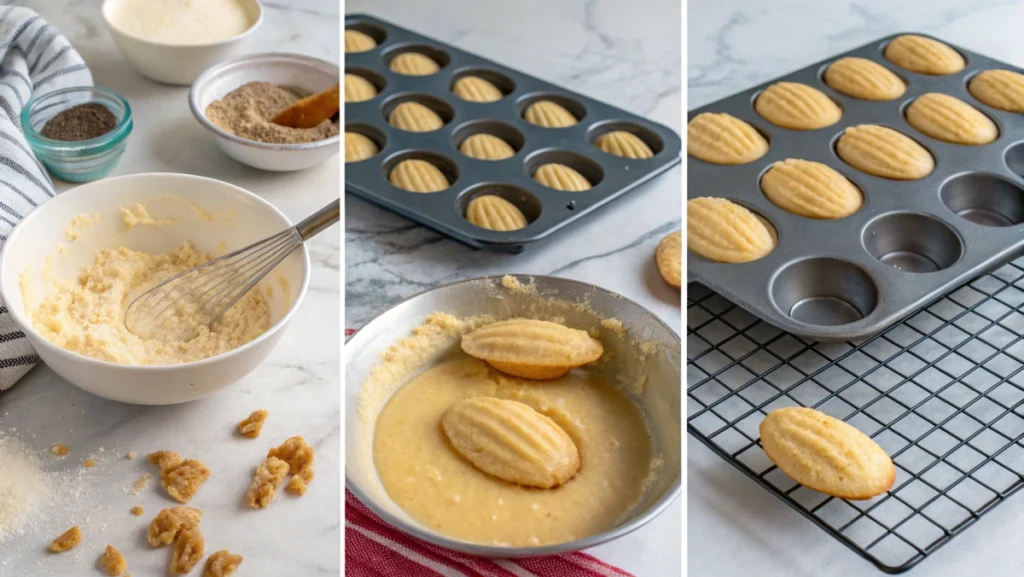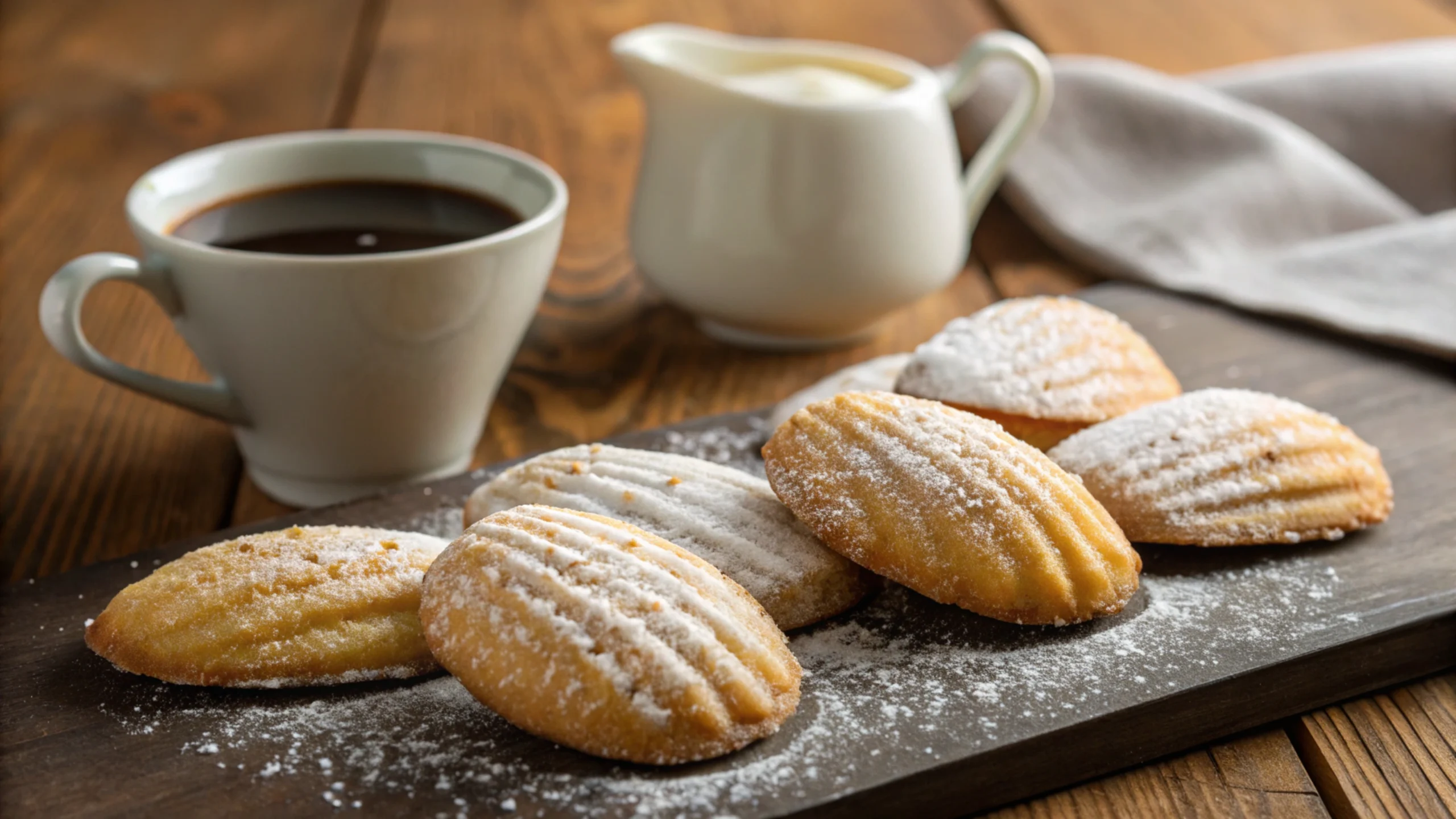Who doesn’t love a warm, buttery treat that melts in your mouth? Madeline cookies, with their delicate, shell-like shape and light sponge texture, are a dessert lover’s dream. But what if we told you that adding cream to the recipe takes these classic French delights to the next level? This article dives into everything you need to know about madeline cookies made with cream—from their history and flavor profile to a step-by-step recipe that’s perfect for both beginners and seasoned bakers. Plus, we’ve thrown in some tips, tricks, and FAQs to help you master this crowd-pleasing dessert. Let’s get started!
Introduction to Madeline Cookies
The Origin and History of Madeline Cookies
Madeline cookies, or simply madeleines, hail from France and have been around since the 18th century. Legend has it that these delicate treats were first created by a young servant named Madeleine in the Lorraine region. Their iconic shell shape and subtle sweetness quickly made them a favorite among French royalty and, eventually, dessert lovers worldwide.
Today, madeleines are enjoyed in countless variations, but the essence of their recipe remains the same—a light, buttery sponge cake baked to perfection. These little delights have even earned a spot in literary fame, thanks to Marcel Proust’s “Remembrance of Things Past,” where the author reminisces about their comforting taste.
Traditional Ingredients and Variations
The classic madeleine recipe uses simple ingredients like flour, sugar, eggs, and butter. However, there’s plenty of room for creativity! Some variations include a splash of vanilla extract, a hint of lemon zest, or a dusting of powdered sugar. When you introduce cream into the mix, the cookies gain an extra layer of richness and moisture, making them even more irresistible.
Importance of Cream in Madeline Recipes
How Cream Enhances Madeline Cookies Recipe Using Cream
Adding cream to your madeline cookies recipe using cream is a simple way to elevate their texture and flavor. Cream provides moisture, giving the cookies a melt-in-your-mouth quality while ensuring they stay tender longer. Its rich fat content also creates a smooth, creamy batter, which translates to a more luxurious final product.
The Role of Cream in Classic French Cookies
In traditional French baking, ingredients like butter and eggs are celebrated for their texture-enhancing qualities. Cream, however, adds a whole new dimension, combining the fluffiness of eggs with the richness of butter. In madeline cookies with cream, this ingredient balances the delicate sweetness with a depth of flavor that’s impossible to resist.
Enhancing Texture and Moisture with Cream
Adding cream to your madeline cookies recipe isn’t just a fancy twist—it’s a game-changer. Cream works wonders by introducing a smooth, rich texture that elevates these little cakes from good to unforgettable. Unlike traditional recipes that rely solely on butter for moistness, cream adds an extra layer of tenderness. This means your madeleines will stay soft and pillowy longer, even if you bake them a day ahead.
The secret lies in cream’s fat content. It blends seamlessly with the other ingredients, creating a batter that produces cookies with a delicate crumb. When baked, these madeleines boast a melt-in-your-mouth quality that’s impossible to resist.
Flavor Profile: Cream’s Contribution
Let’s talk flavor. Cream brings a subtle richness that enhances the buttery and vanilla notes traditionally found in madeleines. It also softens the edges of the sweetness, giving the cookies a balanced and sophisticated taste. If you’ve ever wanted your madeleines to taste like a cross between a sponge cake and a dreamy dessert, cream is the ingredient to make it happen.
Pro tip: Opt for heavy whipping cream for maximum impact—it’s thick, luscious, and perfect for creating that unmistakable texture and flavor.
Essential Equipment for Baking Madelines
Madeleine Molds: Choosing the Right One
To nail a madeline cookies recipe using cream, the right tools are essential, and a proper madeleine mold is at the top of the list. These molds give the cookies their signature shell shape. Metal molds are ideal because they distribute heat evenly, ensuring your cookies bake to golden perfection. If you’re short on options, silicone molds work too, though they may not give the same crisp edges.
Other Baking Tools Needed
Don’t stop at molds! A good whisk is crucial for whipping air into your batter, and a mixing bowl with enough space for folding ingredients smoothly is a must. You’ll also need a small pastry brush to grease the molds—this prevents sticking and helps achieve that perfect hump on the cookies. Oh, and don’t forget a cooling rack! Freshly baked madeleines need air circulation to maintain their soft yet slightly crisp texture.Ingredients for Madeline Cookies Recipe Using Cream
Essential Ingredients for Cream-Based Madeleine Cookies
To bake the perfect batch of cream-based madeleine cookies, gather these essentials:
- Flour: Gives the cookies their structure.
- Eggs: Creates the sponge-like texture.
- Sugar: Sweetens the batter.
- Unsalted Butter: Adds a buttery richness.
- Heavy Cream: The star ingredient for moistness.
- Vanilla Extract: For a classic flavor.
- Baking Powder: Ensures a good rise.
- Optional Zests or Flavorings: Customize with lemon or orange zest.
Substitutions for Madeline Cookies Recipe Using Cream
If you need substitutes, here are great options:
Vanilla Extract: Almond extract offers a nutty alternative.
Heavy Cream: Swap with coconut cream for a dairy-free version.
Butter: Use plant-based margarine.
Flour: Gluten-free all-purpose flour works well for those with dietary restrictions.
Remember, substitutions can change the texture and taste, so experiment to find what suits your palate best.

Step-by-Step Recipe for Madeline Cookies Using Cream
Preparing the Batter
- Melt the Butter: In a small saucepan, melt the unsalted butter over low heat. Once melted, set it aside to cool to room temperature.
- Mix Dry Ingredients: In a bowl, whisk together the flour and baking powder until well combined.
- Beat Eggs and Sugar: In a separate large bowl, beat the eggs and granulated sugar using an electric mixer on medium speed until the mixture becomes pale and thick, about 5 minutes.
- Add Flavorings: Gently fold in the vanilla extract and optional lemon zest into the egg mixture.
- Combine Dry and Wet Ingredients: Gradually sift the flour mixture into the egg mixture, folding gently to maintain the batter’s lightness.
- Incorporate Cream and Butter: Slowly add the heavy cream, folding it in until just combined. Finally, fold in the cooled melted butter until the batter is smooth and glossy.
Incorporating Cream into the Mixture
Adding cream to the batter enhances the moisture and tenderness of the madelines. Ensure the cream is at room temperature to prevent curdling. Fold it in gently to maintain the batter’s airy consistency, resulting in a soft and delicate crumb in the finished cookies.
Filling the Madeleine Molds
- Prepare the Molds: Generously grease the madeleine molds with butter and lightly dust with flour to prevent sticking.
- Chill the Batter: Cover the batter with plastic wrap and refrigerate for at least 30 minutes. Chilling helps achieve the characteristic hump on the cookies.
- Fill the Molds: Spoon the chilled batter into the prepared molds, filling each about three-quarters full. Avoid overfilling to prevent overflow during baking.
Baking Time and Temperature
- Preheat the Oven: Preheat your oven to 375°F (190°C).
- Bake: Place the filled molds in the oven and bake for 10-12 minutes, or until the edges are golden brown, and the centers spring back when lightly touched.
- Cool: Remove the molds from the oven and let them cool for a few minutes. Gently release the madelines from the molds and transfer them to a wire rack to cool completely.
For more delicious recipes, check out our recipe article.
Enjoy your freshly baked madeline cookies with a cup of tea or coffee!
Tips for Achieving the Perfect Madeleine Hump
Chilling the Batter
One of the secrets to creating madeline cookies using cream with that iconic hump lies in the batter’s temperature. After mixing, cover the batter tightly with plastic wrap and refrigerate it for at least 30 minutes, though an hour is even better. This cooling period allows the butter in the batter to solidify, which helps the cookies rise quickly when they hit the hot oven, forming that signature bump.
Oven Temperature Strategies
Temperature control is another key factor. Start by preheating your oven to 375°F (190°C). For the first few minutes of baking, the high heat activates the leavening agents and encourages the hump to rise. Avoid opening the oven door too soon, as this can cause the cookies to deflate. Once the hump is set, you can lower the heat slightly to ensure even baking without over-browning the edges.
Flavor Variations for Madeleine Cookies with Cream
Adding Citrus Zests to Your Madeline Cookies Recipe Using Cream
A teaspoon of lemon or orange zest can transform your madeleine cookies recipe using cream into a citrusy delight. Mix the zest into the batter for a refreshing twist that pairs beautifully with tea.
Chocolate and Nut Variations for Madeleine Cookies
Take your madeline cookies recipe with cream to new heights with chocolate and nuts. Fold mini chocolate chips into the batter or drizzle baked cookies with melted chocolate. For crunch, sprinkle chopped pistachios or almonds over the batter before baking.
Serving Suggestions
Pairing with Beverages
Madeline cookies using cream are the ultimate pairing treat. Their buttery, delicate texture makes them a perfect match for a warm cup of tea, like Earl Grey or chamomile. Coffee lovers will also appreciate how these cookies complement a creamy latte or a robust espresso. For an indulgent twist, serve them with a small glass of milk or even hot cocoa—perfect for cozy evenings!
Presentation Ideas
Presentation matters when serving these elegant cookies. Arrange them on a decorative plate or a tiered dessert stand, dusted lightly with powdered sugar for a classic look. For a fancy occasion, you can plate them alongside fresh berries and a dollop of whipped cream. Hosting a party? Create an eye-catching dessert platter by mixing madeleines with macarons, truffles, or fruit tarts. Your guests will be impressed by both the taste and the display!
Storing and Preserving Freshness
Best Practices for Storage
To keep your madeline cookies using cream soft and flavorful, proper storage is essential. Place them in an airtight container once they’ve cooled completely to prevent them from drying out. If you’re stacking the cookies, separate the layers with parchment paper to avoid sticking.
Store the container at room temperature for up to 3 days. However, for the freshest taste, enjoy them within the first two days—they’re hard to resist anyway!
Freezing Madeline Cookies
Need to make your madelines ahead of time? No problem! These cookies freeze beautifully. Place the cooled cookies on a baking sheet lined with parchment paper and freeze until solid. Then, transfer them to a freezer-safe bag or container. They’ll keep for up to a month.
When you’re ready to enjoy them, let the cookies thaw at room temperature for about 30 minutes. If you prefer warm madeleines, a quick zap in the microwave (10 seconds) works wonders!
Frequently Asked Questions (FAQs)
What is the difference between financiers and madeleines cookies?
Financiers and madeleines are both classic French pastries, but they differ in texture, shape, and ingredients. Madeleines are light, fluffy, and shell-shaped cookies with a sponge cake-like consistency. They are often flavored with vanilla, lemon zest, or even cream. Financiers, on the other hand, are dense, almond-flavored cakes made with browned butter and baked in rectangular molds. While madeleines pair perfectly with tea, financiers are rich and ideal as a standalone treat.
How do you keep madeleines moist?
Keeping madeline cookies using cream moist is easy with proper storage. The key is to store them in an airtight container at room temperature. Adding cream to the batter also helps lock in moisture, giving the cookies a tender texture. If you plan to keep them for longer than a day or two, freezing is the best option to retain their freshness.
What is a substitute for madeleine molds?
If you don’t have a madeleine mold, you can still enjoy these delightful cookies! Substitute with a mini-muffin tin or shallow cupcake molds. While the cookies won’t have the classic shell shape, they’ll still taste amazing. For a more authentic look, grease the molds well and slightly underfill them to mimic the classic madeleine thickness.
Why do madeleines taste so good?
Madeline cookies using cream taste amazing because of their rich, buttery flavor and light, delicate texture. The addition of cream enhances the moistness and adds a subtle richness that makes each bite melt in your mouth. Pair that with the slight crunch of their golden edges, and it’s no wonder they’re a beloved treat!
Why do madeleines have a hump?
The iconic hump forms because of the batter chilling process and high oven heat. When the cold batter hits the hot oven, it creates a quick rise, leading to the characteristic bump. This feature is a hallmark of a well-made madeleine, and chilling the batter beforehand is key to achieving it.
Can I make madeleines without cream?
Yes, you can! While cream adds extra moisture and richness, traditional recipes often use milk or rely solely on butter for texture. If you’re looking for a dairy-free option, you can use coconut cream or almond milk as a substitute. The result will still be delicious, though slightly different in texture and flavor.
For more tasty dessert ideas, check out other recipes on Nourishous Recipes.


2 thoughts on “Madeline Cookies Recipe Using Cream: A Delectable French Delight”